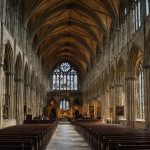Overview of Medieval Cathedrals in the UK
The medieval period, a pivotal era in history, significantly influenced architectural development, especially in the construction of cathedrals. These grand structures not only served religious purposes but also played a critical role in historical and cultural contexts. Medieval cathedrals in the UK are prime examples of how architecture can reflect the societal values and technological advancements of their times.
Cathedrals from this era exhibit a variety of architectural styles, including Romanesque and Gothic, each characterised by distinct features such as flying buttresses, ribbed vaults, and pointed arches. These design elements were not merely aesthetic choices; they were technological innovations that allowed for higher and more resilient structures, which have stood the test of time.
Have you seen this : Join the Fun: A Guide to Experiencing Traditional English Cider-Making Workshops in Somerset
The historical significance of these cathedrals is vast. They were often situated at the heart of towns and cities, serving as centers for community gatherings, education, and spiritual refuge. Architecturally, they symbolised the wealth and power of the church and monarchy, whilst also showcasing the artistic talents of the era’s craftsmen.
Among the most renowned medieval cathedrals in the UK are Canterbury Cathedral, with its stunning stained glass windows, and York Minster, noted for its intricate facade. Each cathedral tells its own story through its architectural grandeur and historical importance, making them treasures of the UK’s heritage.
Also to see : Discover the Top Guided Tours to Uncover the Rich History of British Coal Mining
Prominent Medieval Cathedrals to Explore
Embark on a journey through time by visiting notable cathedrals that are celebrated for their architectural highlights and historical importance. These grand structures offer not only a spiritual refuge but also a glimpse into the intricate artistry and history intertwined with British religion.
Canterbury Cathedral
Situated in the heart of Canterbury, this cathedral is a masterpiece of Gothic architecture, with its origins tracing back to 597 AD. As the seat of the Archbishop of Canterbury, its historical significance in the English church is unparalleled. The cathedral is renowned for its stunning nave, which exemplifies the Perpendicular Gothic style. Noteworthy features include the beautiful stained glass windows that depict biblical stories and details of its rich history, as well as the shrine of Thomas Becket, which holds profound importance for pilgrimage.
York Minster
York Minster stands as one of the largest gothic cathedrals in Northern Europe. It is renowned for its intricate stonework and architectural highlights, such as the stunning Rose Window and the impressive Chapter House. Its historical significance is profound, having been a centre of ecclesiastical power since the 7th century. Explore its notable interior adorned with biblical narratives and intricate carvings, each illustrating its legacy in British religious history.
Durham Cathedral
Experience the majesty of Durham Cathedral, a UNESCO World Heritage Site, known for its pioneering Norman architecture. The cathedral’s ribbed vaulting and towering nave set architectural precedents that influenced Romanesque style across Europe. Its importance in British history is marked by the Tomb of Saint Cuthbert, making it a revered pilgrimage site. With its breathtaking artistic elements, Durham Cathedral remains a testament to the spiritual and cultural heritage of medieval Britain.
Guided Tour Options and Experiences
When exploring cathedrals, guided tours offer an invaluable way to enhance your visit. Diverse guided tours are available, each designed to cater to different interests and preferences. Whether you’re interested in historical insight, architectural grandeur, or spiritual journeys, there’s an option for everyone.
Several renowned tour companies specialize in cathedral tours. These companies offer a range of immersive experiences that bring the history and stories of cathedrals to life. For instance, some tours integrate interactive technology, such as virtual reality, to showcase the past grandeur of these historical sites, providing a vivid picture that enhances understanding. Others might include thematic storytelling or concerts to elevate the visit with cultural dimensions.
Some companies allow guests to experience parts of the cathedral not usually open to the public. An example is climbing to bell towers or accessing crypts, enabling a more comprehensive exploration. Furthermore, these tours often employ experienced guides who offer deep insights and answer any questions that may arise, truly enriching the overall experience.
Immersive experiences can transform an ordinary visit into a memorable adventure, leaving attendees with a deeper appreciation for the rich cultural heritage and architectural magnificence of cathedrals.
Historical Background of Key Cathedrals
Understanding the historical evolution of cathedrals is essential to grasp their architectural and cultural significance. Cathedral history is marked by a timeline filled with significant events. Starting in the Gothic era, marked by the construction of soaring arches and detailed stained glass, the architecture was not just a reflection of technological advancement but also an embodiment of spiritual aspirations.
As centuries progressed, these architectural styles evolved, responding to changing influences both from within and outside the church. Romanesque architecture, characterized by robust and heavy structures, slowly gave way to the delicate and ornate Gothic designs. These transitions reveal a deep cultural heritage influenced by regions and politics of the time.
Furthermore, the cultural influences played a pivotal role in shaping the design and construction processes of cathedrals. Local materials, available technology, and cultural exchanges via trade and conquest contributed to unique regional styles. From the pragmatic fortifications seen in French cathedrals to the intricate carvings adorning the façades of Spanish churches, these buildings narrate stories of a unifying faith amidst diverse cultures.
Delving into the historical backdrop of these architectural marvels invites us to appreciate the blend of art, history, and faith that cathedrals encapsulate, vividly showcasing the cultural heritage of their times.
Tips for Selecting the Right Tour
Choosing the right tour can greatly enrich your visitor experience and transform your trip into an unforgettable adventure. Here are some essential tips for effective tour selection.
Researching Tour Options
Begin with thorough research into various tour options available. Utilise online resources, guidebooks, and tourism boards to gather as much information as possible. This will help you understand the best tours that are tailored to your interests and needs, ensuring a more fulfilling experience.
Understanding Tour Types
Different types of tours cater to varying preferences, be it cultural immersion, adventure, or leisurely exploration. Guided tours often provide valuable insights from local experts but may lack flexibility. Self-guided options offer more freedom to explore at your own pace, whereas group tours can foster camaraderie among like-minded travellers. Choose the type that best aligns with your expectations and travel style.
Considering Group Sizes and Accessibility
When selecting a tour, consider both the group size and the tour’s accessibility. Smaller groups often allow for a more personalized experience, whereas larger groups might feel impersonal. Evaluate accessibility features such as the ease of travel for those with disabilities. This ensures comfort throughout the journey.
In addition, always check firsthand reviews and testimonials from past visitors. These insights provide invaluable, unbiased evaluations to guide your decision confidently.
Practical Information for Visitors
When planning a visit, understanding the visiting guidelines is essential. Cathedrals typically have distinct hours, often influenced by seasonal changes. It’s advisable to check specific times, as they can vary during holidays or special events.
Ticket Pricing and Discounts
Pricing for entry can differ among cathedrals, with some offering free admission and others charging a fee. Discounts are frequently available for students, seniors, and families, making visits more affordable. It’s beneficial to visit cathedral websites or contact them directly for the latest deals and promotions.
Accessibility Considerations
Ensuring accessibility is a priority at many cathedrals. Key features often include ramps, elevators, and accessible restrooms, catering to visitors with mobility challenges. It’s recommended to check for specific accessibility services in advance. For example, some cathedrals provide wheelchair rentals or guided tours that accommodate different abilities. This information aids in planning a hassle-free experience, allowing all visitors to appreciate these magnificent structures fully.
Remember to respect the guidelines regarding photography and quiet zones, ensuring a pleasant and peaceful visit for everyone. By being aware of these aspects, you can enjoy a seamless visit, full of history and beauty.
Nearby Attractions and Activities
Discovering nearby attractions when visiting a cathedral can greatly enhance your travel experience. Beyond exploring the architectural beauty and historical significance of cathedrals, many noteworthy sites await discovery close by. For instance, around the stunning Notre-Dame Cathedral, you might explore the iconic Seine River for a serene boat ride or enjoy a leisurely walk through the picturesque streets of Île de la Cité.
To gain deeper cultural insights, consider engaging in local tours or activities that highlight the area’s rich heritage. Many cities offer guided walking tours focusing on historical landmarks, culinary experiences, or local art scenes. These tours are tailored to provide a comprehensive understanding of the region’s history and culture, offering a perfect complement to your cathedral visit.
Further immersing yourself in the local scene, seek recommendations for cultural experiences that reflect the area’s lifestyle. These might include visiting nearby markets, attending art exhibitions, or enjoying a traditional performance. Such activities not only enrich your travel experience but also connect you with the vibrant cultural landscape surrounding these majestic cathedrals.
By embracing these local experiences, you create memorable and meaningful connections with both the place and its people, allowing a more enriched journey that extends well beyond the cathedral walls.















